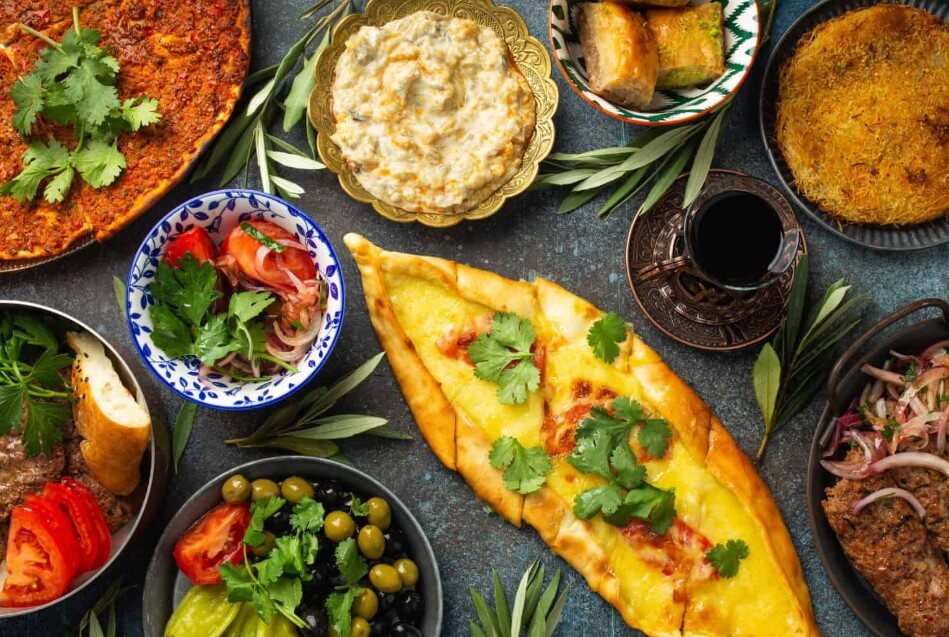Turkey is a country where history, geography, and culture intersect to create one of the richest culinary traditions in the world. From the Aegean coast to the mountains of Eastern Anatolia, and from the Mediterranean shores to the bustling streets of Istanbul, Turkish cuisine reflects centuries of cultural exchange, local ingredients, and regional diversity. It is a culinary journey that combines fresh produce, aromatic spices, traditional cooking techniques, and a deep respect for communal dining.
The Foundation of Turkish Cuisine
At the heart of Turkish cuisine lies the use of fresh, seasonal ingredients. Olive oil, vegetables, grains, legumes, dairy products, and fresh herbs form the backbone of everyday cooking. Meat, particularly lamb, beef, and poultry, is widely used, often prepared in slow-cooked stews, roasted dishes, or kebabs. Turkish meals emphasize balance, combining flavors, textures, and colors to create a harmonious dining experience.
Regional Diversity
Turkey’s culinary culture is incredibly diverse, shaped by geography and local traditions:
Aegean Cuisine
The Aegean region is known for its light and healthy dishes, heavily influenced by olive oil and fresh vegetables. Staples include dishes such as zeytinyağlılar (vegetables cooked in olive oil), fresh seafood, and herbs like dill, parsley, and mint. The cuisine emphasizes freshness, simplicity, and natural flavors, making it a paradise for those who appreciate wholesome Mediterranean-style meals.
Southeastern and Eastern Anatolia
Southeastern and Eastern Anatolia are famous for rich, spicy, and hearty dishes. Ingredients like lamb, bulgur, eggplant, and peppers dominate this region. Signature dishes include kebabs, lahmacun (Turkish-style thin flatbread with minced meat), baklava, and künefe, a sweet cheese dessert soaked in syrup. The region also showcases unique spices and cooking techniques that have been passed down through generations.
Central Anatolia
Central Anatolian cuisine is characterized by its use of wheat, legumes, and dairy products. Breads, pastries, and bulgur dishes are staples here. Signature meals include mantı (Turkish dumplings filled with meat), keşkek (a traditional wheat and meat dish), and various stuffed vegetables. The region combines rustic simplicity with deeply rooted culinary traditions.
Mediterranean and Black Sea Cuisine
The Mediterranean coast emphasizes seafood, fresh vegetables, and citrus fruits, reflecting its sunny climate and fertile soil. Mezes, grilled fish, and dishes incorporating tomatoes, peppers, and olives are typical. The Black Sea region, in contrast, is known for its corn-based dishes, anchovies, and hearty stews that sustain locals in colder climates. Hamsi (anchovies) and mısır ekmeği (cornbread) are staples of this area.
Traditional Turkish Meals and Hospitality
A hallmark of Turkish culinary culture is hospitality and communal dining. Meals are social events, often shared with family and friends, and accompanied by stories, tea, and laughter. Traditional Turkish breakfasts, or kahvaltı, are elaborate affairs featuring bread, cheeses, olives, tomatoes, cucumbers, eggs, honey, jams, and simit (sesame-encrusted bread rings). Lunches and dinners often begin with mezes, small appetizer plates, followed by main courses and finishing with desserts like baklava or şekerpare.
Turkish Beverages
Turkish cuisine is complemented by a variety of beverages, both hot and cold. Turkish tea (çay) is a cultural symbol, enjoyed throughout the day in small tulip-shaped glasses. Turkish coffee, with its rich aroma and thick consistency, is traditionally served alongside sweets. Ayran, a yogurt-based drink, is often paired with kebabs and grilled dishes, offering a refreshing balance to flavorful meals.
Culinary Heritage and Modern Influence
Turkey’s culinary culture is both ancient and evolving. Traditional recipes are preserved in homes and restaurants, while contemporary chefs reinterpret classic dishes with innovative techniques. Turkish cuisine has influenced neighboring regions for centuries and continues to gain international recognition for its flavors, variety, and authenticity.
Conclusion
Turkish culinary culture is a vibrant tapestry of flavors, colors, and traditions that reflect the country’s rich history and geographical diversity. From aromatic herbs and spices to hearty stews, fresh seafood, and sweet pastries, Turkish cuisine offers something for every palate. It is more than just food—it is an expression of identity, hospitality, and the joy of sharing meals with others. Experiencing Turkish cuisine is not only a journey through taste but also an immersion into the heart of Turkey’s cultural heritage.



